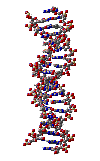|
Could a protein have saved Salem’s witches from burning at the stake? (01/2004)
Huntington’s disease (HD), a fatal degenerative disorder of the brain, can be alleviated by administration of a protein known to promote neuron survival, say scientists in the January’s journal Experimental Neurology 1
Diana Zala, Jean-Charles Bensadoun, Luis Pereira de Almeida and colleagues show that long-term administration of Ciliary Neurotrophic Factor (CNTF), a nerve growth stimulator, improves the early symptoms of HD and seems to control the disease progression.
Huntington’s disease is a devastating brain disorder that results from the specific destruction of the brain cells involved in the voluntary control of movements. Disease symptoms involve mental and mobility disturbances; patients suffer from mood swings, memory problems and present uncoordinated and involuntary movements. As the disease progresses and symptoms get worse patients become incapable of walking, moving or even swallowing. Eventually they are unable to care for themselves and death soon follows from complications such as choking or lung infection.
The death of the brain tissue is a slow process but inexorably drives patients to death after years of suffering from a highly debilitating physical and psychological deterioration.
Interestingly, researchers working with family trees have traced HD to the infamous witch trials of 17th century America such as the ones in Salem, Massachusetts. They hypothesise that some of those women could have been suffering from HD with its convulsive movements and mental perturbations.
It is known that the cause of HD is a single abnormal gene. Genes are composed of deoxyribonucleic acid(DNA) and DNA is made up of combinations of four different individual chemicals called bases: adenine (A), thymine (T), guanine (G) and cytosine (C). Each group of three bases encodes an amino acid, which are the blocks that build proteins.
The genetic defect responsible for HD is an abnormal repetition (more than 36 times) of a three base sequence CAG that encodes the amino acid glutamine. When this anomalous repetition occurs, the aberrant protein responsible for HD is produced.
Although the gene involved in HD was identified already in 1993 there is still no cure for the disease and death is inevitable for those carrying the mutated version of the gene. While we search for a cure, with all the difficulties involved in trying to change a genetic defect, the development of treatments that can alleviate the disease symptoms and the suffering of patients is equally important.
Furthermore, an accurate animal model of the disease is crucial to understand the underlying course of the illness and to test possible treatments.
Zala, Bensadoun, Pereira de Almeida and colleagues tested the use of CNTF as a possible HD treatment. In this research they use for the first time a combination of an animal model where disease originates in the same way as the original human disease -– by a specific multiplication of the single gene - and a virus, genetically modified to produce CNTF, the beneficial protein. The virus is injected into the affected zone of the mouse’s brain and infects cells inserting the DNA encoding for CNTF into the cells DNA. This will create “modified” cells that now have the information to produce the beneficial protein directly into the affected area of the brain.
Contrary to other studies where disease is induced by drugs, the animal model of HD used in this work originates disease in much the same way as their human counterpart and so the findings are more relevant than those from previous work. Furthermore, it is also shown that the viral system created to allow long-term delivery of CNTF into the affected area is reliable, effective and avoids the side effects usually associated with systemic application of drugs. This is important as it makes it a possible tool to be used in human treatments.
Diana Zala, and Jean-Charles Bensadoun work at the Institute of Neurosciences in Lausanne, Switzerland while Luis Pereira de Almeida works in the Faculty of Pharmacy and Centre for Neuroscience in Coimbra, Portugal.

1 Experimental Neurology (2004); Vol (185), issue 1, pp. 26-35
Original paper’s authors
Diana Zala - diana.zala@epfl.ch
Jean-Charles Bensadoun - jean-charles.bensadoun@epfl.ch
Luis Pereira de Almeida is a Portuguese scientist that works on gene therapy for the treatment of neurodegenerative disorders at the Center for Neurosciences of Coimbra and is an assistant professor at the Faculty of Pharmacy of the University of Coimbra, Coimbra, Portugal
|
In collaboration with the Observatório da Ciência e do Ensino Superior (OCES)
Financed by the Fundação para a Ciência e Tecnologia (FCT) |





